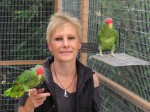Ursula Heise brought home a Jardine’s parrot about 20 years ago when she passed by a pet shop. It was the first animal that attracted her attention, but not the last.
She became inspired by how well the parrot understood and imitated people and joined bird-watching groups, a hobby that would later become a professional endeavor. Having experience primarily as an English professor, Heise decided to find a way to combine the study of narratives with biodiversity.
Heise, who also teaches at the Institute of the Environment and Sustainability, published a book “Imagining Extinction” about two months ago that explores how people discuss nature and extinction based on their cultural background.
Heise is now one of the leaders of UCLA’s goal to focus on the environmental humanities, an interdisciplinary subject that addresses relations between environmental science and social literature, history and media.
[Related: Foundations donate $250,000 to fund environmental law programs]
Heise was hired to teach the interdisciplinary subject in 2012 along with associate English professor Allison Carruth and history professor Jon Christensen.
Carruth said she is glad scholars are paying more attention to social science when studying natural science.
“Scientific narratives can also be a cultural phenomenon,” Heise said. “We are not entirely objective even when discussing a pure scientific problem. (We) are influenced by culture, such as the media we use and the community we are a part of.”
Heise’s passion for animals has impressed many of her colleagues and students, Carruth said.
“Professor Heise is the most avid and knowledgeable bird-watcher I know,” she said. “From her, I’ve learned what magical and intelligent creatures birds are and that environmental damage nowadays has put them under threat.”
Heise said she thinks the stories people tell about nature are often closely tied to stories from their own community.
For example, in her book Heise discusses how the story of the Japanese Honshu wolf’s extinction was influenced by Japanese history.
The wolf officially died out in 1905 but many Japanese scholars claimed the wolf became extinct between the 1940s and 1950s. Heise said Japanese scholars may have related the species to a time when they lost important values in their community.
“(The) 1940s was the time when Japan lost the war and got imposed with Western ideas,” Heise said. “The wolf, among all these animals, represents the traditional Japan and (Japan’s) harmonious relations to nature – it’s their nostalgia.”
Heise’s studies also aim to broaden the definition of social justice to include biodiversity conservation. She said she thinks people need to empathize with other living creatures, not just humans.
“It’s true (that) social justice varies even among countries,” Heise said. “But in order to make biodiversity conservation socially just, we need to have forums and mechanisms so that all voices can be heard and interests of nonhumans can be included too.”
This is why more scholars from various departments become interested in narratives, Heise said. She added she thinks narratives are one of the most essential tools for social debate, through which people share their different voices.
Heise also encourages her students to tell stories about the natural environment around them, even if they do not have a strong scientific background.
“The students nowadays are the next generation to lead nature conservation and their perspectives are crucial,” Heise said. “Sometimes I am amazed at how creative and passionate their narratives are.”
Tyler Huxtable, who was a student in Heise’s “Environment and Narratives” course last spring, said the class helps students view nature in a new way and recognize the nuanced relation between humans and nature.
Students sometimes think of environmental studies as a big scientific problem not related to people’s lives, Huxtable said. But he learned from Heise’s course that people’s perceptions and cultural ideas play a major role in discussion of these problems.
“We are more related to nature than we have expected,” Huxtable said. “When I start to tell my own stories about nature, I learn how we should view other species by seeing humans as one of the species too.”
Heise said she wants to push more students on campus to tell stories about nature through diverse media such as photography, video and even comics.
This year, she co-founded the Laboratory for Environmental Narrative Strategies at UCLA with Carruth and Christensen. The lab works to promote sustainability through storytelling in different mediums on campus.
[Related: Students intern in Uganda to grow a safer, cleaner environment]
“Bringing more narratives into environmental humanities is not only a way for people to learn about nature,” Heise said. “Their voices diversify and vitalize the study itself.”
